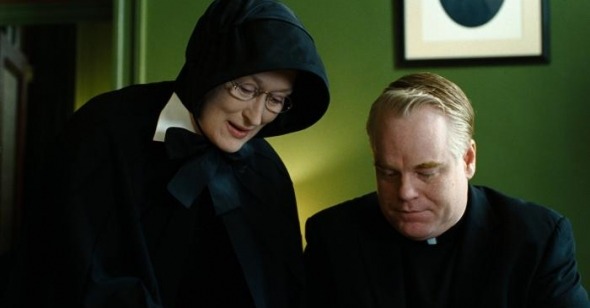The Play's the Thing
by Chris Wisniewski
Doubt
Dir. John Patrick Shanley, U.S., Miramax
On paper, John Patrick Shanley did everything right in bringing his Pulitzer Prize-winning play Doubt to film. He adapted the screenplay and directed himself, assembled a cast with 17 Oscar nominations to their collective credit, and brought in the extraordinary cinematographer Roger Deakins. Given the strength of the source material and the pedigree of its cast and crew, Doubt may be the ultimate low-risk, high-reward prestige product, and it would be wrong for me to suggest that Shanley has produced anything less than a gripping piece of work. Despite its many virtues, though, Doubt is also bloodless. Handsome, well played, and oddly forgettable, it never manages to live up to the promise of its big ideas and heady speeches.
Doubt is the sort of movie that often gets described as “an actor’s picture,” partly because almost every scene features some combination of its four principals colluding with, confronting, or lecturing one another, and also because two of its four featured cast members are Meryl Streep, stepping into a role that earned Cherry Jones a Tony, and the recently Oscared Philip Seymour Hoffman. Streep plays the imperious Sister Aloysius Beauvier, the principal of a Catholic grammar school in the Bronx.
The year is 1964. The times they are a-changing, with the Second Vatican Council in full swing, and Father Brendan Flynn (Hoffman), a gentle and warm young priest, has recently joined the parish. When one of the school’s teachers (Amy Adams) begins to suspect Father Flynn of improper sexual conduct towards the school’s first black student, she expresses her concerns to Sister Aloysius, who immediately decides that Flynn is guilty and sets off to prove the veracity of the allegations. Despite the contemporary resonance of the priest-abuse angle, Doubt is very much a period piece, steeped in the political, social, and religious currents of the era in which it’s set.
As the film’s title suggests, Shanley uses his premise to explore the nature of faith and uncertainty, but he also means to examine structures of power and patriarchy in a time of institutional change. Sister Aloysius is the sort of woman who leads by intimidation, while Father Flynn inspires with affection. “They’re all uniformly terrified of you!” Flynn complains to Aloysius. “Yes,” she retorts, “that’s how it works.” Flynn is, of course, a man, and he’s also on the side of history, but Shanley does not dismiss Aloysius as a relic, a villain, or a crone. Among Streep’s recent performances, her Aloysius most resembles The Devil Wears Prada‘s Miranda Priestly, except with a habit and a Bronx accent: She battles Flynn with steely conviction and an icy, lacerating condescension, while betraying a thinly concealed vulnerability. She has neither the influence nor the charm of her adversary, and so she clings too desperately to her moral certainty and the small, circumscribed authority she has.
Hoffman has the more complex role to play—perhaps hero, perhaps villain, he moves from endearing kindness to righteous indignation to something that is finally quite ambiguous (is it repose, or guilt?). Both give excellent performances that fall just short of ranking with their finest work, but they are somewhat upstaged by a thrilling Viola Davis, who plays the alleged victim’s mother. In her one pivotal scene, which completely reconfigures the movie’s emotional and moral topography, she gives Doubt the heft it otherwise lacks.
Though its ideas are big, Doubt‘s scope is small and its sensibility theatrical. In translating it to the screen, Shanley has tried to open it up with some distracting visual flair. So a sermon about gossip gets literalized in a flurry of falling feathers, and overhead shots, canted frames, and high and low angles proliferate. Too often, Shanley’s flourishes lack sufficient motivation or feel overdetermined (are the overhead shots meant to invoke a divine presence, or do they simply give us an opportunity to admire the design of Aloysius’s light and umbrella?). For better and worse, he tries awfully hard to make Doubt into more than merely a filmed version of his play.
In his only other film as a director, the underrated gem Joe vs. the Volcano, Shanley demonstrated a visual whimsy perfectly suited to the material, but Doubt doesn’t lend itself to self-conscious camerawork. It was a great play, and it is a fine film. Indeed, it may even win Oscars (whatever that may be worth). But I am quite sure of this: Joe vs. the Volcano is a better movie.
